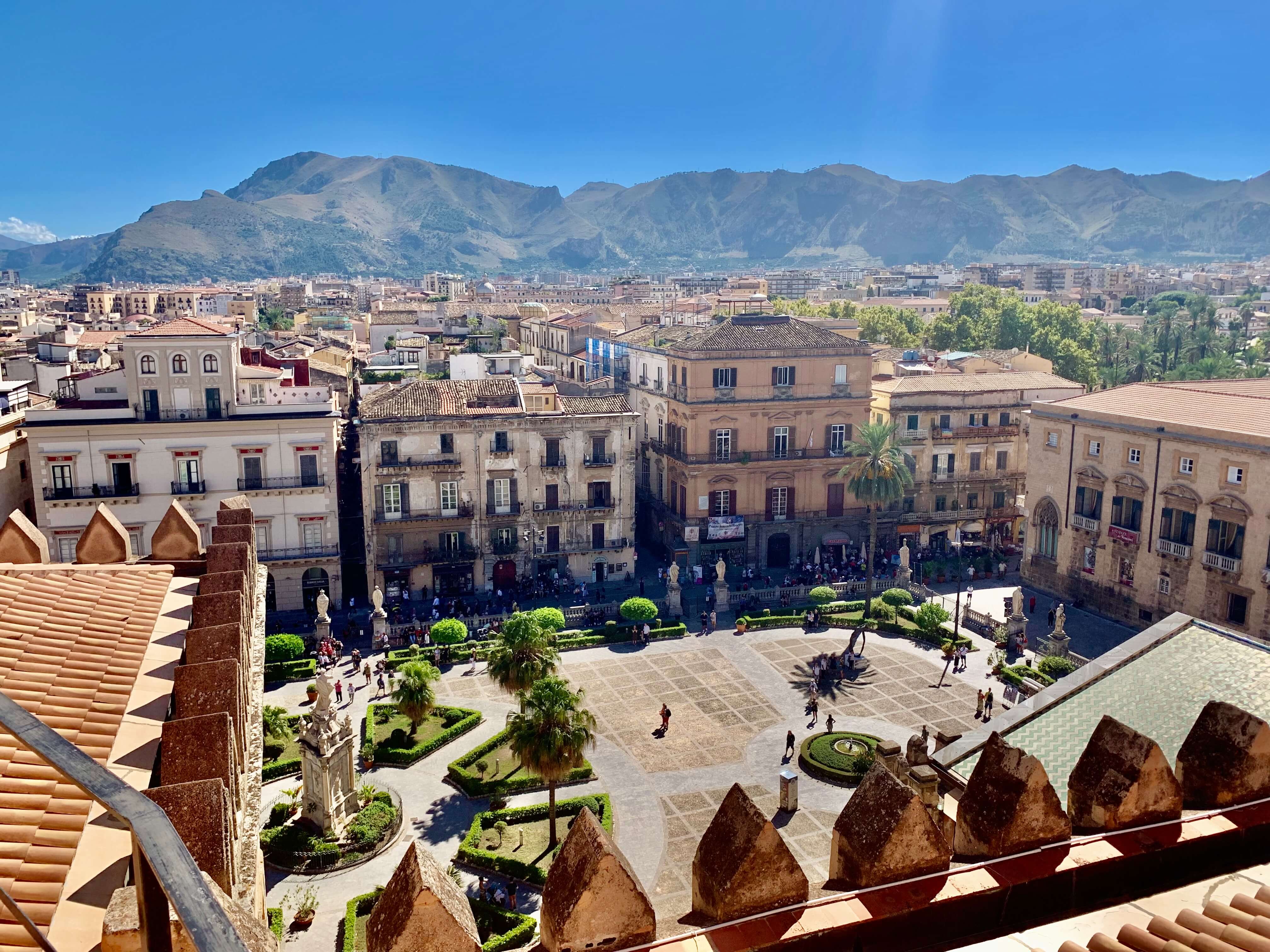- Home
- Things to Do in Sicily
- Roman Ruins in Sicily
Uncovering the Imperial Splendor: Exploring the Ancient Roman Ruins in Sicily

Step back in time and visit the ancient Roman ruins in Sicily. Nestled among breathtaking landscapes and azure coastlines, these majestic remnants of a bygone era tell tales of an empire that once reigned supreme.
From the imposing theater of Syracuse to the remarkably preserved mosaic floors of Villa Romana del Casale, each of the ancient Roman ruins in Sicily tells its unique story of this once great civilization.
The History of Roman Presence in Sicily
Throughout history, Sicily has been under the rule of different invaders. The Greeks arrived in 700 BC, followed by the Romans.
The Romans were brought to the island by their wars against Carthage. Sicily was conveniently halfway between Rome and North Africa, where Carthage was. The first war between Carthage and Rome is called the First Punic War.
The Romans won that war. Along the way, they conquered a large part of western Sicily. This happened in 241 BC.
 Cities involved in Punic Wars. (Wikimedia Commons)
Cities involved in Punic Wars. (Wikimedia Commons)However, Carthage did not bend to Rome's will. The Second Punic war ended only when Carthage was utterly destroyed.
After that, the Romans did not leave Sicily alone. They laid siege to Syracuse, the island's capital, for three years. Finally, Syracuse was defeated and passed into Roman hands in 212 BC.
With Syracuse, Sicily became a Roman colony. The centuries to come were not happy for the Sicilians.
The Romans were primarily interested in the island's strategic location and fertile soil. In return, they offered poverty and suffering.
The island was soon full of slaves, either Sicilians or brought there from elsewhere. Rebellions arose and were put down with bloodshed.
The Roman governor Verres was a particularly notorious ruler. His actions went so far that the great—but at the time relatively unknown—Roman orator Marcus Tullius Cicero was called in.
Cicero defended the Sicilians against the tyranny of Verres in speeches that have since become legendary. Cicero won the court case. The rest is history, at least for Cicero.
 Famous Roman orator Marcus Tullius Cicero (106 BC - 43 BC).
Famous Roman orator Marcus Tullius Cicero (106 BC - 43 BC).Roman rule in Sicily continued even after the collapse of Western Rome. After that, the island was ruled by an emperor living in Constantinople.
It was not until the 5th century AD, that Roman rule finally fell.
Romans left only a few ruins behind them - except ruins of Greek buildings that they had destroyed. However, some Roman ruins have survived to this day.
So, here are the most famous ancient Roman Ruins in Sicily.
Exploring the Ancient City of Syracuse
Although the period under Roman rule wasn't that happy for Sicilians, some well-functioning towns, including Syracuse and Catania, remained in eastern Sicily.
Syracuse was the most crucial town in the island at the time. After three years of naval siege, the Romans conquered it in 212 BC.
The former center of Syracuse is now an archaeological park. It is just a short walk from the current town center.
The archaeological park is known, above all, for its Greek theatre. However, it also contains some of the most important ancient Roman ruins in Sicily, the most notable of which is the Roman amphitheater.
The theatre dates back to the first Christian century. Unlike the Greek theatre, it is no longer used for public performances - perhaps because gladiator fights are no longer fashionable.
 Roman amphitheater in the archeological park in Syracuse.
Roman amphitheater in the archeological park in Syracuse.It is still a great attraction. The pool in the middle of the theatre was used for fighting with aquatic animals. The bottom of the arena was covered in sand, which conveniently absorbed the blood that had been spilled. At the other end of the oval-shaped arena is an arch under which the losers were carried out of the arena.
Sarcophagi have been placed on the upper platform around the theatre. They come from a Greek cemetery discovered while constructing a nearby road.
The Roman Amphitheater in Taormina
The better name would be the Greco-Roman Theatre of Taormina. The Greeks built this magnificently situated theatre in 300 BC, and the Romans significantly improved it later.
But it is not an amphitheater. To be an amphitheater, it would have to be circular, but the Romans did not make it a circle. The reason was apparent: the theatre is located on a hillside. It would have been impossible to build on air.
However, almost everything that remains of the theatre is Roman. In addition to the general renovation work, the auditorium's bottom ten rows of seats were removed, giving the troupe more space for the gladiator shows.
The Romans also built a wall to protect the spectators from the wild beasts used in the shows.
The Greco-Roman Theatre of Taormina is still used as a summer musical performance stage. The once erect but now ruined back wall gives way to a view of the volcano of Mount Etna and the Ionian Sea.
 Greek-Roman theatre is sitting on top of the hillside in Taormina.
Greek-Roman theatre is sitting on top of the hillside in Taormina.Visiting the Roman Amphitheater in Catania
Catania is a city that will hardly leave anyone cold. The Roman amphitheater is in a courtyard amid the hustle and bustle of traffic and modern apartment blocks.
The theatre is built of lava stone, also used in many of the city's apartment blocks.
At one time, the theatre could seat 15,000 spectators. One can only wonder how they have managed to fit in.
The theatre is easily accessible. It is close to the city center and many of the city's other main attractions.
Catania's location in the popular sea route, halfway between Africa and Rome, made it a perfect stop for shipments of wild animals. The ones that wouldn't make it the rest of the way to Rome were dropped off here.
Here, they were given the dubious honor of providing entertainment for a bloodthirsty public.
Today, the wild animals are long gone. What is left are a bunch of local cats. They lounge in the sun or prowl the ruins, quietly watching the tourists go by.
 Inside the Roman theatre in Catania.
Inside the Roman theatre in Catania.Exploring the Villa Romana del Casale in Piazza Armerina
Mosaics were a common way of covering floors in ancient Rome. At first, they used simple geometric patterns; later, the patterns became more realistic.
Eventually, the Romans became skilled mosaicists. The tiniest stones used were only the size of the head of a pin.
After the collapse of Western Rome, the tradition of mosaic art continued in the Byzantine Empire, as evidenced by the Hagia Sophia in Istanbul.
The Villa Romana del Casale mosaics date back to the 300s AD. By then, the Roman Empire had already passed its glory days. It was in slow decline. The nobility fled this decline to their remote rural villas.
The mosaics of Villa Romana del Casale are the best preserved from that period. The remote location made it lucky; many future conquerors couldn't tear it apart.
In addition, a landslide covered the site in the 13th century, leaving it untouched for the next six hundred years.
 Villa Romana del Casale in Piazza Armerina has an extraordinary collection of Roman mosaics in their original surroundings.
Villa Romana del Casale in Piazza Armerina has an extraordinary collection of Roman mosaics in their original surroundings.Today, it is the best-preserved reminder of ancient Rome in Sicily. The villa's owner is unknown, but it is thought to have been owned by a Roman senator and exotic animal importer.
This, at least, is what the mosaic motifs suggest.
And there are a lot of mosaics here. Definitely one of Sicily's main attractions.
Conclusion: The Timeless Attraction of Ancient Roman Ruins in Sicily
The Romans held Sicily for almost a thousand years, longer than any other conqueror. That's why the number of ancient Roman ruins in Sicily is surprising: there are few.
This is because Sicily served mainly as a granary for the Romans. Its strategic location in the middle of the Mediterranean was also of interest.
Some cities, such as Catania and Syracuse, flourished under Roman rule. However, most of the island was farmland.
Still, there are some ancient Roman ruins in Sicily. The most notable is the house of a Roman nobleman in the central part of the island, Villa Romana del Casale.
Roman theatres can be found in Syracuse, Catania, and Taormina. They are all conveniently close to other main attractions and worth visiting.
(This page last edited: March 17, 2025)
Recent Articles
-
Sicilian Food - Rich Flavors, Endless Passion
Apr 09, 25 09:54 AM
All you need to know about Sicilian food, its ingredients and history. -
Things to Do in Palermo - Tips for a Perfect Holiday
Apr 05, 25 04:27 AM
Things to Do in Palermo - From historic landmarks to delicious food, this guide has it all. -
The Story of Tommaso Buscetta: From Mafia Boss to Key Witness
Mar 30, 25 05:12 AM
Tommaso Buscetta built Sicilian Mafia into a global empire - which he then destroyed.
Follow MANY FACES OF SICILY on Facebook, Instagram, Bluesky & Pinterest
Contact: vesa@manyfacesofsicily.com





